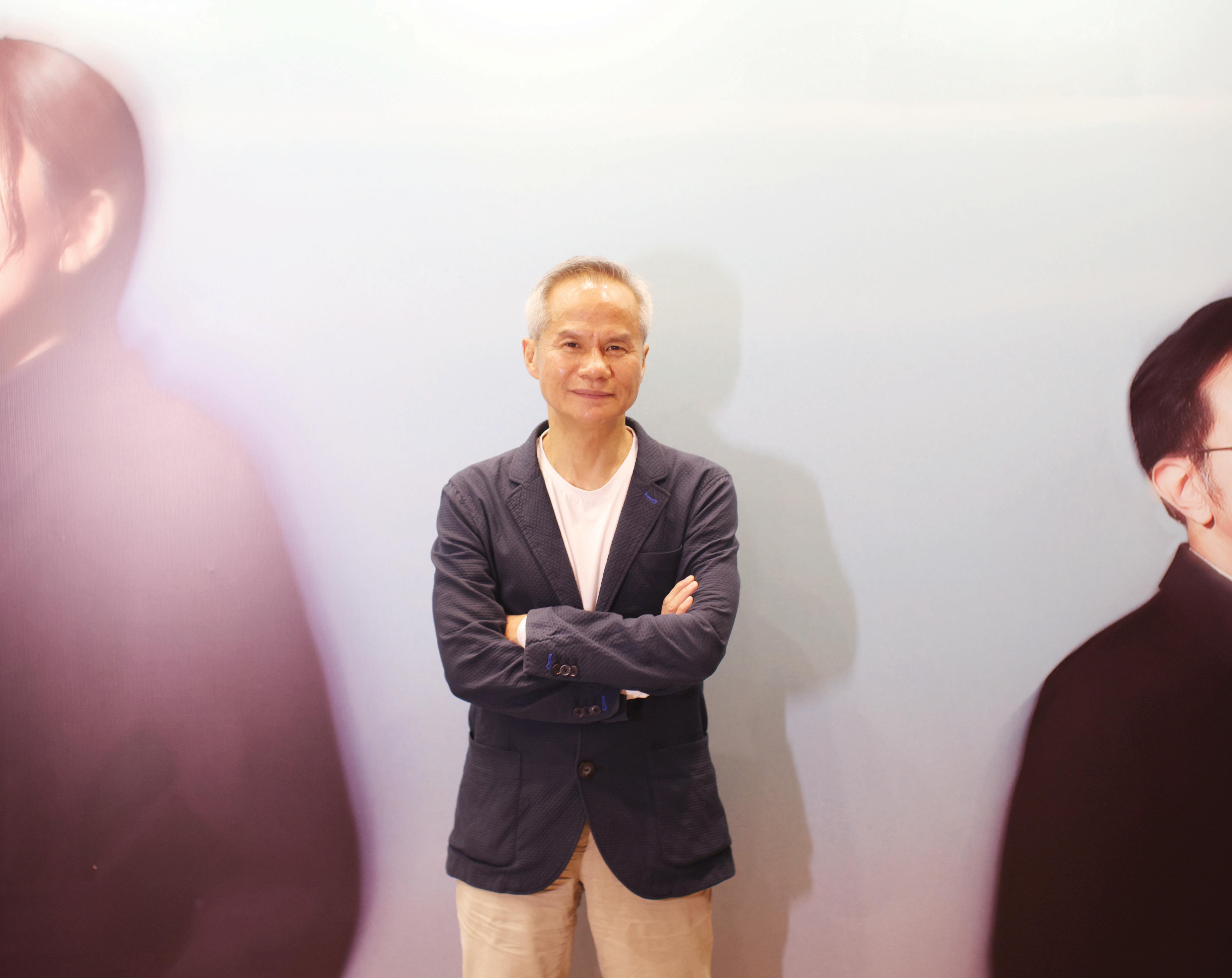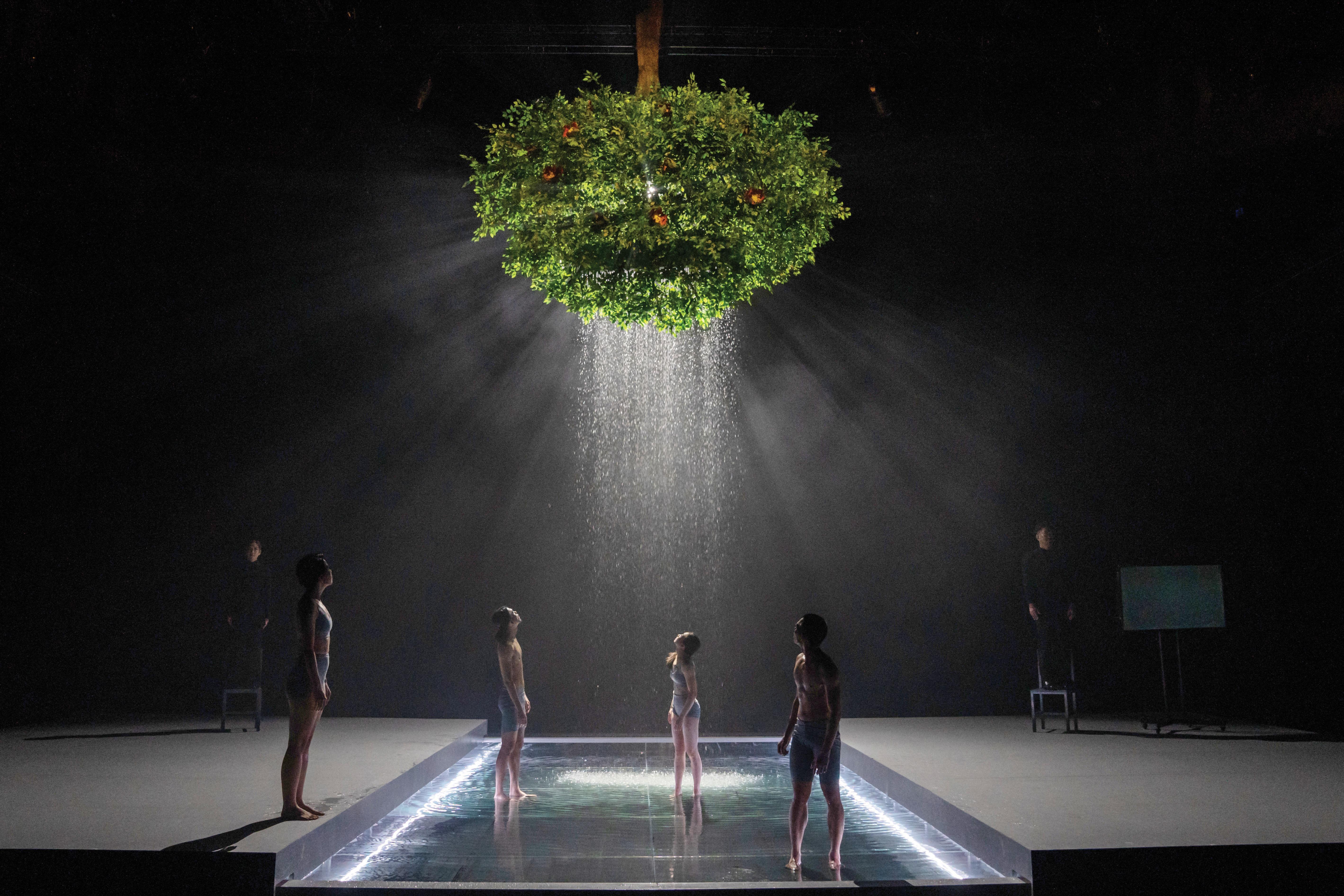The third installment of our series on groundbreaking work produced this year by Hong Kong artists features thespian Tang Shu-wing. For his latest directorial venture, Bhagavad Gita, Tang adapted a 700-verse Hindu scripture embedded in the Indian epic, the Mahabharata, for the stage, showcasing what old-world concepts such as moral duty, disinterested action and renunciation of worldly attachments reveal about our own time. Chitralekha Basu reports.
 Director Tang Shu-wing’s anxiety about the future of humanity in an increasingly mechanized age finds expression in Bhagavad Gita. (EDMOND TANG / CHINA DAILY)
Director Tang Shu-wing’s anxiety about the future of humanity in an increasingly mechanized age finds expression in Bhagavad Gita. (EDMOND TANG / CHINA DAILY)
Bernice Chan is a keen follower of works by Tang Shu-wing, the artistic director of the eponymous Tang Shu-wing Theatre Studio. And yet, watching Tang’s latest production, Bhagavad Gita, staged at the West Kowloon Cultural District from June 16-25, Chan, who manages the Hong Kong chapter of the International Association of Theatre Critics, was in for a few surprises.
From the get-go it was apparent that Bhagavad Gita could be a watershed in the repertoire of the director, who has been putting on plays in Hong Kong since 1997.
“It was like joining a guided meditation,” Chan says of the production, named after the Hindu scripture it is adapted from.
The original Bhagavad Gita is embedded in the 1.8 million-word Indian epic the Mahabharata, in the form of a dialogue between the Pandava prince Arjuna and his charioteer, Lord Krishna, who is a god incarnate. Determined to win back their share of the kingdom from their cousins, the Pandava brothers, led by star warrior Arjuna, decide to start a war against them. Once he had sighted the enemy in the battlefield, however, Arjuna is reluctant to kill his own kinsmen. That is when Krishna reveals that Arjuna is only a cog in the wheel of a grand design orchestrated by him: The fate of the battle is decided before it takes place, and the cousins are already slain.
Krishna’s elaborate occupational therapy lecture, which forms the crux of the 700 verses of the Bhagavad Gita, touches on a range of ethical and moral issues. Tang has picked a number of key concepts from this text, such as dharma (moral duty), karma yoga (disinterested action) and the three human behavioral traits of sattva (spiritualism); rajas (hedonism) and tamas (depravity), trying to critically examine their relevance and applicability in the current context. Tang’s theatrical rendering of the Bhagavad Gita is, essentially, a compilation of his reflections on the state of the world today as seen through the lens of an ancient Indian classic whose appeal extends far beyond its pan-Hindu following.
Though the Mahabharata, or episodes of it, have been adapted for the stage, most famously perhaps by the British master thespian Peter Brook, no one in India, or elsewhere, has tried making theater out of the Bhagavad Gita. It’s not difficult to see why.
 Mandy Wong and Chu Pak-him serve as both narrators and characters in the tale they narrate in the play. (PHOTO PROVIDED TO CHINA DAILY)
Mandy Wong and Chu Pak-him serve as both narrators and characters in the tale they narrate in the play. (PHOTO PROVIDED TO CHINA DAILY)
Adapting a bunch of abstruse metaphysical ideas from an ancient Indian text dating back to the first millennium BCE for the stage sounds like an impossible task. The existing models of theatrical forms seem inadequate to make this material speak to a contemporary audience. Tang has combined narration, classical Indian and contemporary dance, dramatic monologues, nonverbal acting, and YouTube videos to present a close and critical reading of concepts that figure in the Bhagavad Gita, and also resonate with our own times, more resoundingly than we sometimes care to recognize. These include the prediction about the coming collapse of humanity as we know it, now increasingly likely due to global warming or the proliferation of artificial intelligence.
He made a conscious decision to put on a play that was too experimental in nature, and far removed from the cultural context of a Hong Kong audience.
“This particular subject matter is neither familiar to a Hong Kong audience and may not be of interest to them. Besides, they might have issues with a text that imagines human beings as bound by fate and not autonomous entities,” says the director.
And yet the capricious nature of human existence felt during the height of the pandemic pushed him to seize the moment and have his say. Having been through those difficult years has made him more certain of his convictions.
“I’m not afraid of whether or not my Bhagavad Gita is liked,” he says. “But if you care to listen carefully, you might find that the words you hear in this production are coming from your own soul and body. Whether you agree with these ideas or not makes no difference. It’s the awareness of such ideas that counts.
“For me this is an attempt at self-questioning and self-purification,” Tang adds, revealing that a number of his colleagues had concerns that the production’s material was too esoteric to attract much of an audience.
Happily, they have been proved wrong. The show played to packed houses, and though there have been people in the audience who admitted they didn’t quite get everything that was going on, some of them approached the director post-performance, hoping to get a clarification or two.
If the goal was to spur the audience into “raising questions about the spiritual paths” available to us, Tang seems to have made it.
 The most striking, and dynamic, stage device used in the Tang Shu-wing-directed Bhagavad Gita is a sculpture of a tree hanging upside down. (PHOTO PROVIDED TO CHINA DAILY)
The most striking, and dynamic, stage device used in the Tang Shu-wing-directed Bhagavad Gita is a sculpture of a tree hanging upside down. (PHOTO PROVIDED TO CHINA DAILY)
Production highlights
Bhagavad Gita, the play, began life as a series of images. Mulling over lines in the original text sparked commonly seen expressions of social behavior to flash across Tang’s mind. Six performers have brought Tang’s vision to life, through nonverbal depictions of frenzied partying, gratuitous smiles for the camera, fanatic pursuit of fitness regimes and mobile addiction.
“I think the archetypes of human behavior as listed in the Bhagavad Gita can be found in our own times,” explains the director. It is not uncommon to meet people driven by herd mentality or with a tendency to give in to a carefree life of unregulated self-gratification. “So I feel the images of contemporary life in my Bhagavad Gita are totally relevant, being from our own neighborhood.”
The existence of surveillance states and military regimes is hinted at, through fleeting displays of the Nazi salute and synchronized goose-stepping. Interestingly, as the director points out, a totalitarian system can in fact begin as a well-intentioned move to protect those in need. Hence the path of sattva, which is about doing good to others, is a great life-governing philosophy to adopt “as long as the person concerned is not trying to preach or forcing others to follow their path”.
One of the highlights of the show is when one of its two unnamed narrators, played by TVB actor Mandy Wong, reimagines the game of dice episode from the Mahabharata. It’s the story of how the Pandava brothers came to lose all their worldly possessions to their cousins through gambling, leading to a public shaming of their common wife Draupadi. Wong impersonates a range of characters — violated woman, amoral perpetrator, gloating cheerleader and silent bystander — as she brings to life one of the book’s most emotionally charged chapters, embodying the characters as well as standing at one remove from the goings-on at the same time.
Tang’s technique of adopting such stylized modes of story-telling has been compared to the German master thespian Bertolt Brecht’s theory of alienation, but in this case he need not have looked for inspiration beyond the Mahabharata writer Vedavyas who is both the narrator of and a character in his own story.
The director agrees. “Increasingly I’m more in favor of just telling a story or presenting it visually rather than have it enacted, particularly in this case where my style conforms to the mode of storytelling in the Mahabharata.”
 The war between the feuding clans in the play is represented by performers who convincingly impersonate a pack of wild dogs, ready to pounce at each other’s throats. (PHOTO PROVIDED TO CHINA DAILY)
The war between the feuding clans in the play is represented by performers who convincingly impersonate a pack of wild dogs, ready to pounce at each other’s throats. (PHOTO PROVIDED TO CHINA DAILY)
AI issues
Chan says that while Tang’s trademark minimalist esthetics, and his ability to make actors, singers (Chu Pak-him who plays the second narrator is a member of the band Juicyning) and dancers work as an ensemble feel familiar, what’s perhaps new in Bhagavad Gita is “his anxiety about the future of humanity”.
The final twist in the plot is the suggestion that at least one of the narrators might be living in a simulation — a contemporary, or futuristic, version of what is revealed in the original Bhagavad Gita to be the infinitesimal universe embodied and controlled by Krishna. In it every outcome has been predetermined and hence beyond the scope of human agency.
In a symbolic gesture of revolting against this system, Chu’s character smashes a TV set blaring stories about humanity’s increasing dependence on artificial intelligence, but later finds himself wired to a realm where the choices have already been made for him.
“The show highlights AI’s power, potentially, to extinguish the human race and also effect an emotional revolution between AI and human beings,” remarks Tang. “I think the future generations might get emotionally dependent on AI, as they will be surrounded by AI-powered systems in their everyday lives.”
Chan’s takeaway from the play is a monumental sacred fig tree sculpture hanging upside down directly above the center stage and the way strategic lighting illuminates its different features by turns, revealing red flowers tucked into its green foliage, at times, for example, signifying the prevalence of rajas, or passion. For her the tree seems to morph into a living, breathing organism during the show, in a way that “resonates with the theme of the work”.
Tang says the sculpture is a visualization of the tree of transmigration mentioned by Krishna in Chapter 11 of the Bhagavad Gita. It is a tree that holds the clues to ultimate liberty. Only by cutting off this “strong-rooted tree” with a “strong sword of dispassion” can a human being break free of the trappings of the material world, or, in Tang’s version, the world of computer simulation.
Tang himself seems to have taken this idea to heart.
“I have reached a stage in my life when I feel I ought to prepare myself for the time when I must take a step back, from life, and from art,” he says, without a hint of emotion.
The converse of this, he hastens to point out, is that “if I want to do something and I have the means of doing it, I want to do it now, rather than later”.
Contact the writer at basu@chinadailyhk.com


